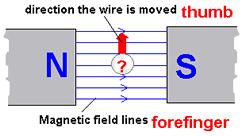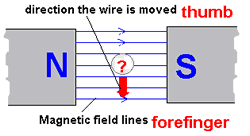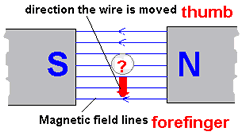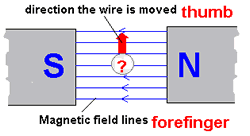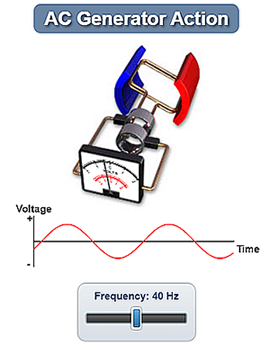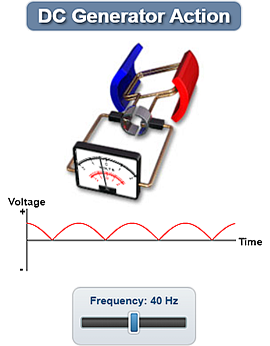Electromagnetic
Induction: The Electric Generator
Electricity can be generated
by rotating a coil of wire in a magnetic field or by rotating a magnet
inside a coil of wire.
This is how a generator works.
If a wire, or coil of wire, cuts
through a magnetic field, or vice-versa, a voltage (potential difference)
is produced between the ends of the wire. This induced voltage causes
a current to flow if the wire is part of a complete circuit. This is called the generator effect,
The size of the induced voltage
increases when:
 the speed of the movement increases;
the speed of the movement increases;
 the strength of the magnetic
field is increased;
the strength of the magnetic
field is increased;
 the number of turns on
the coil is increased;
the number of turns on
the coil is increased;
 the area of the coil is
greater.
the area of the coil is
greater.
A changing magnetic field will also
produce an induced voltage in a coil.
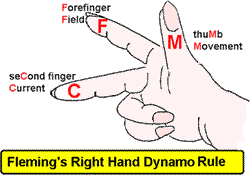
The direction of the induced current is reversed if either the direction of the movement or the direction of the magnetic field is reversed.
It can be found using Fleming's Right Hand Dynamo Rule.
The right hand rule predicts the direction of an induced current and RIGHT has an I in it - the symbol for current! |
Consider
the example below:
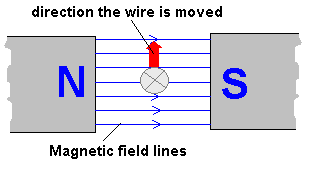
 Hold up your right hand with the fingers mutually at right angles.
Hold up your right hand with the fingers mutually at right angles.
 The
Field is going from N to S (make this your First finger)
The
Field is going from N to S (make this your First finger)
 The wire is being Moved upwards (make this your thuMb)
The wire is being Moved upwards (make this your thuMb)
 This results in the Current flowing into the page (away from you - indicated by the cross in the diagram) -
your seCond finger shows the direction of this
This results in the Current flowing into the page (away from you - indicated by the cross in the diagram) -
your seCond finger shows the direction of this
Try
these examples (mouseover for the solution!):
At GCSE level you
should be able, when provided with a diagram, to explain how an a.c.
generator works, including the purposes of the slip rings and brushes
Here are the links for interactive demonstrations of generators:
Here is a page that explains how a simple a.c. generator works.
Here is a page that explains how a simple d.c. generator works.

Try the electromagnetic
induction wordsearch: click here

A metal
detector works using electromagnetic induction. Click here to see how it works.
Regenerative braking converts kinteic energy into electrical energy rather than kinetic energy into heat - less energy wasted - increasing efficiency.
A 'shaking flashlight' works using electromagnetic induction. |

 One of the best ways to check you understand a topic is to try some past paper questions.
One of the best ways to check you understand a topic is to try some past paper questions.
The link on the right takes you through to some sample questions on this topic.
The solutions do not just give you the 'answer required' but also have comments to explain why the examiner looks for particular words or phrases in an answer.





